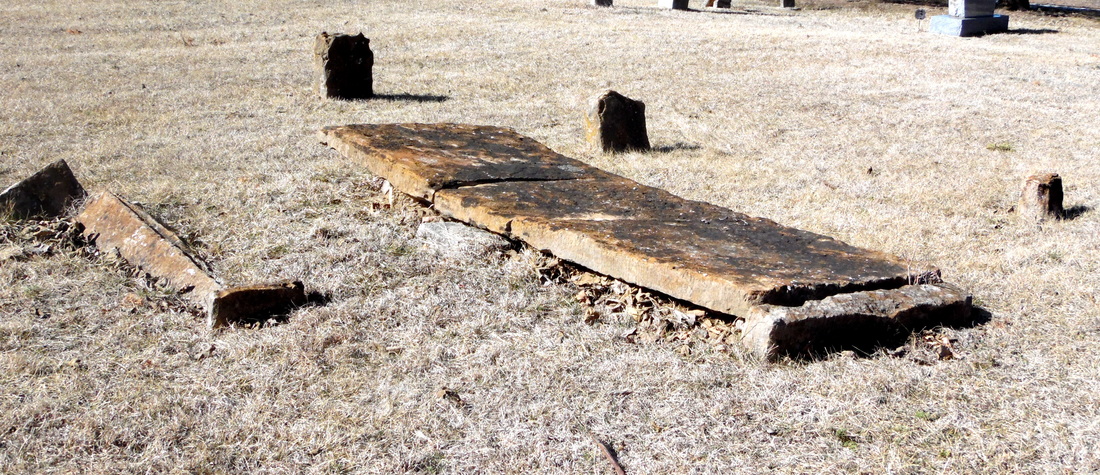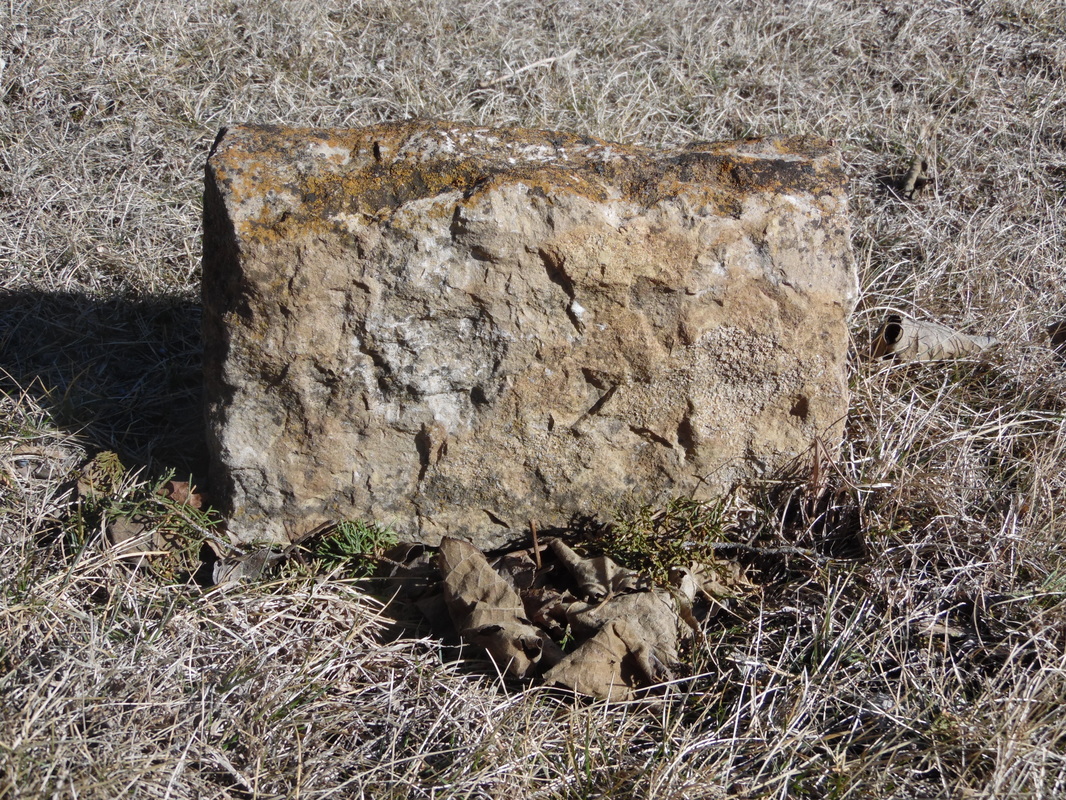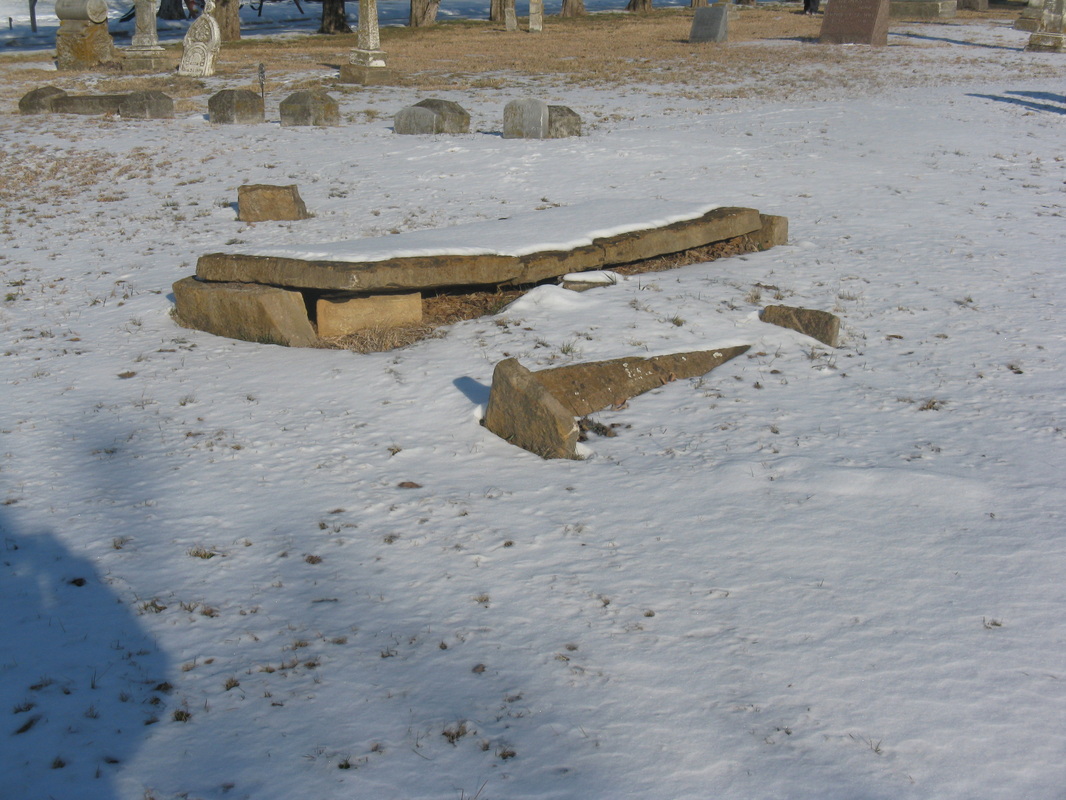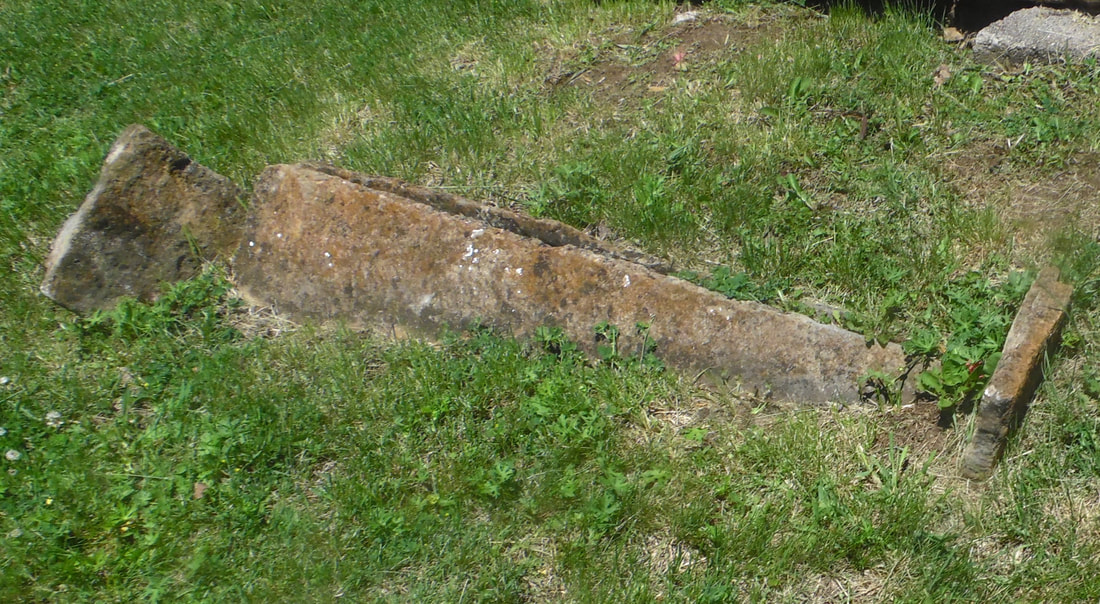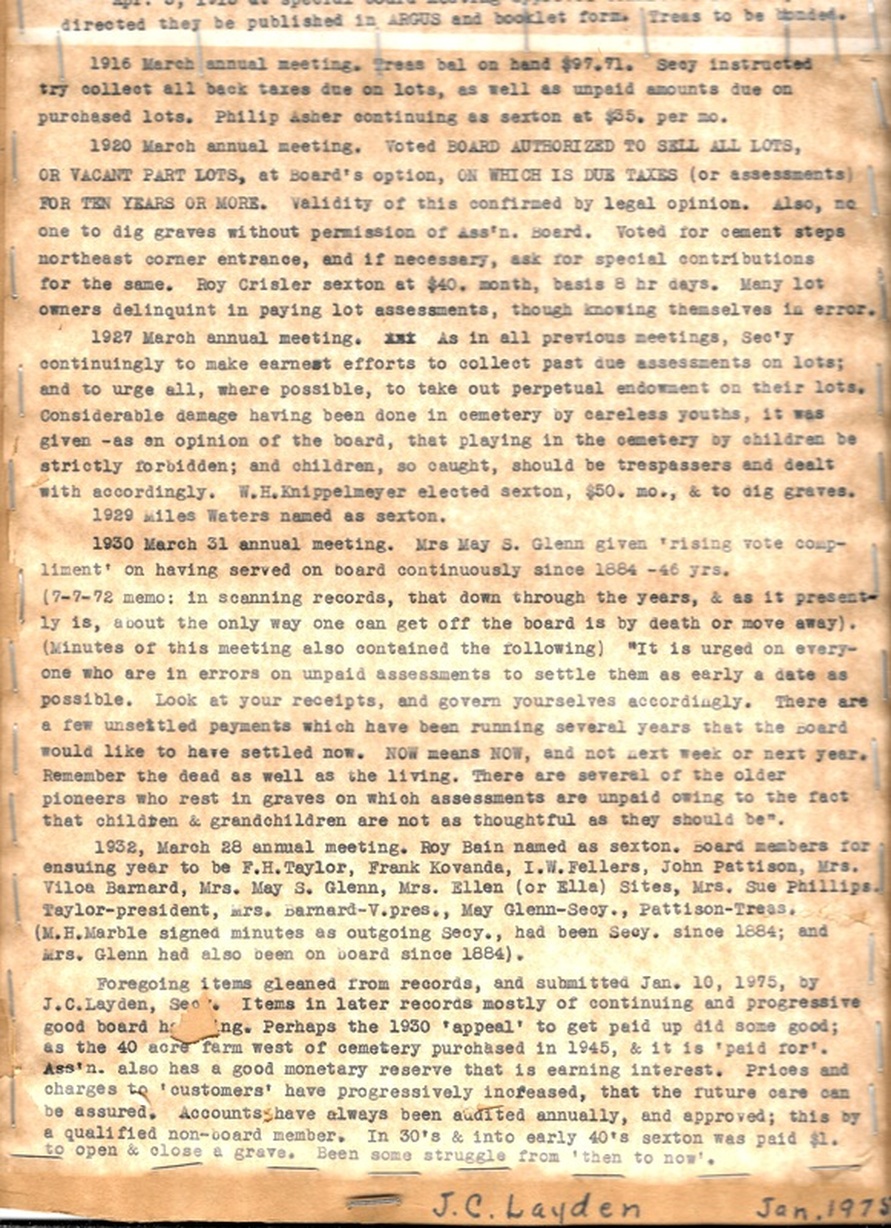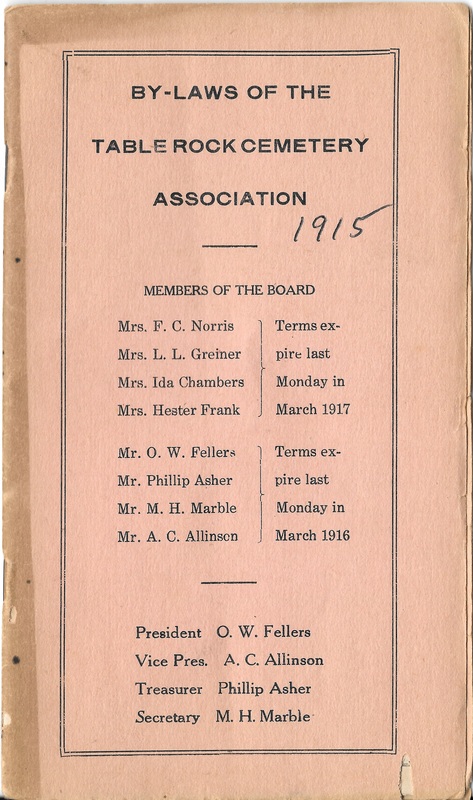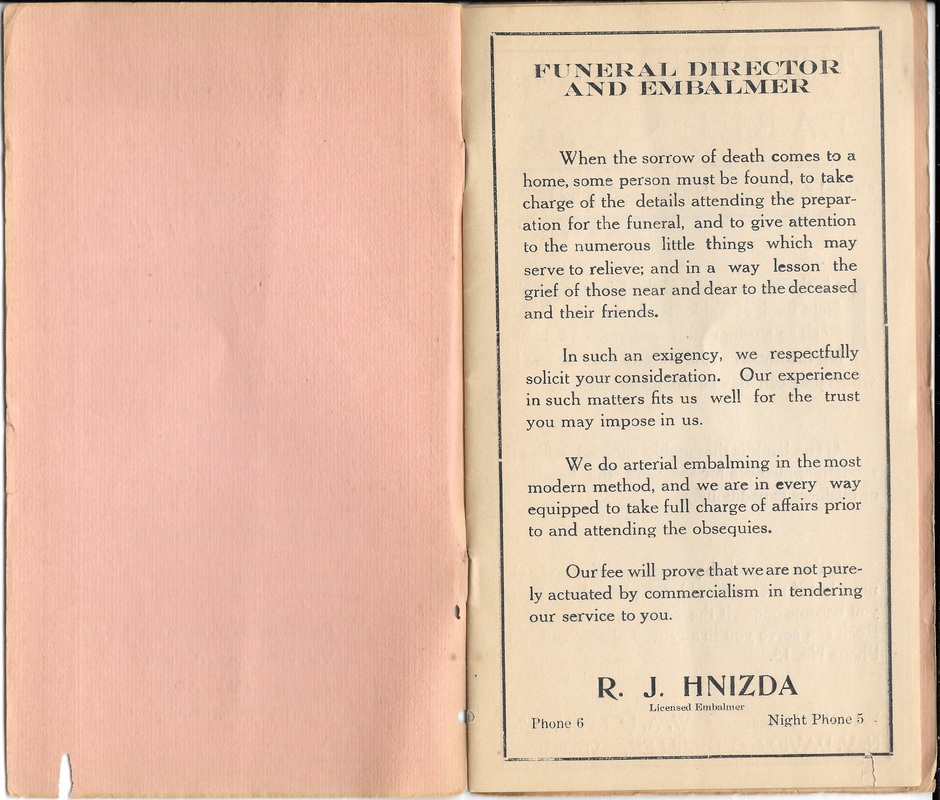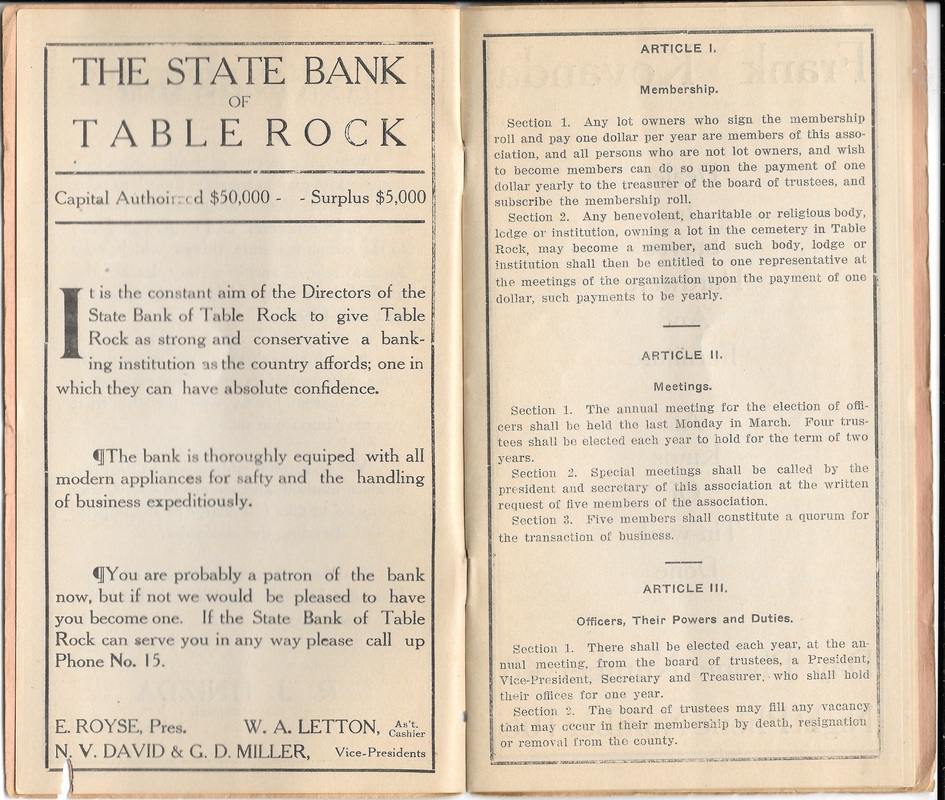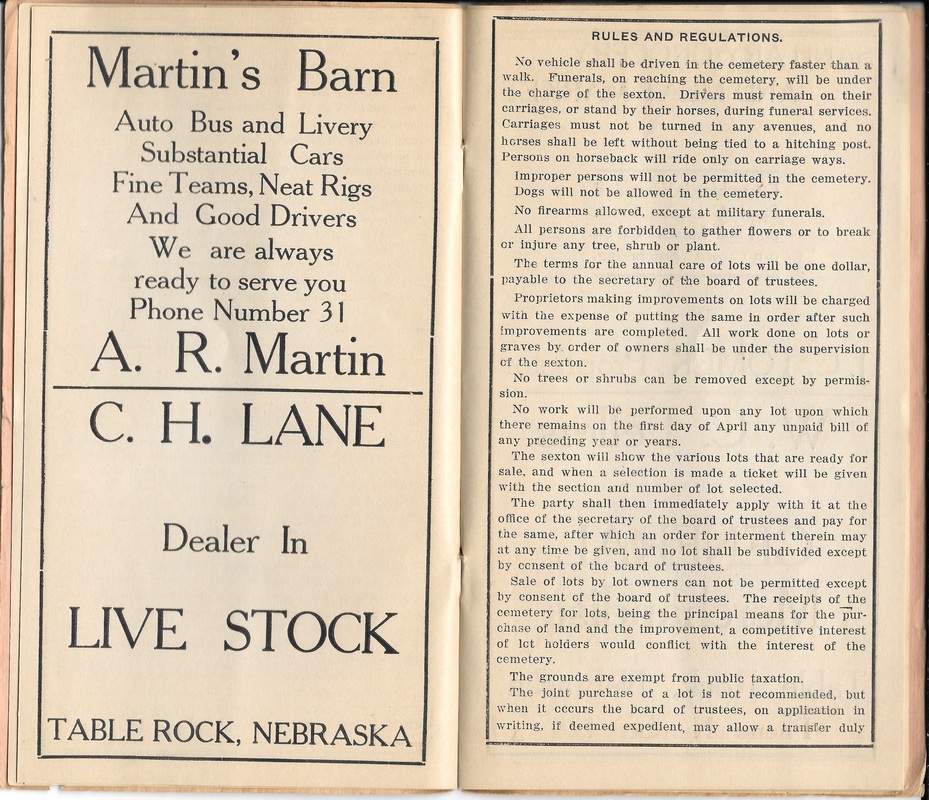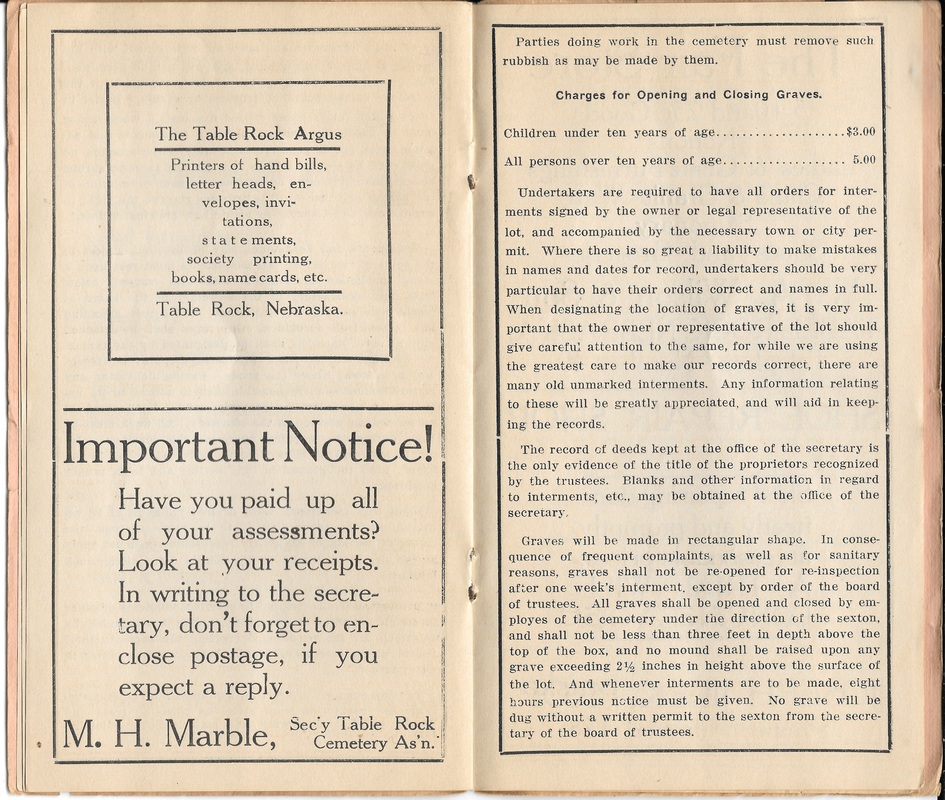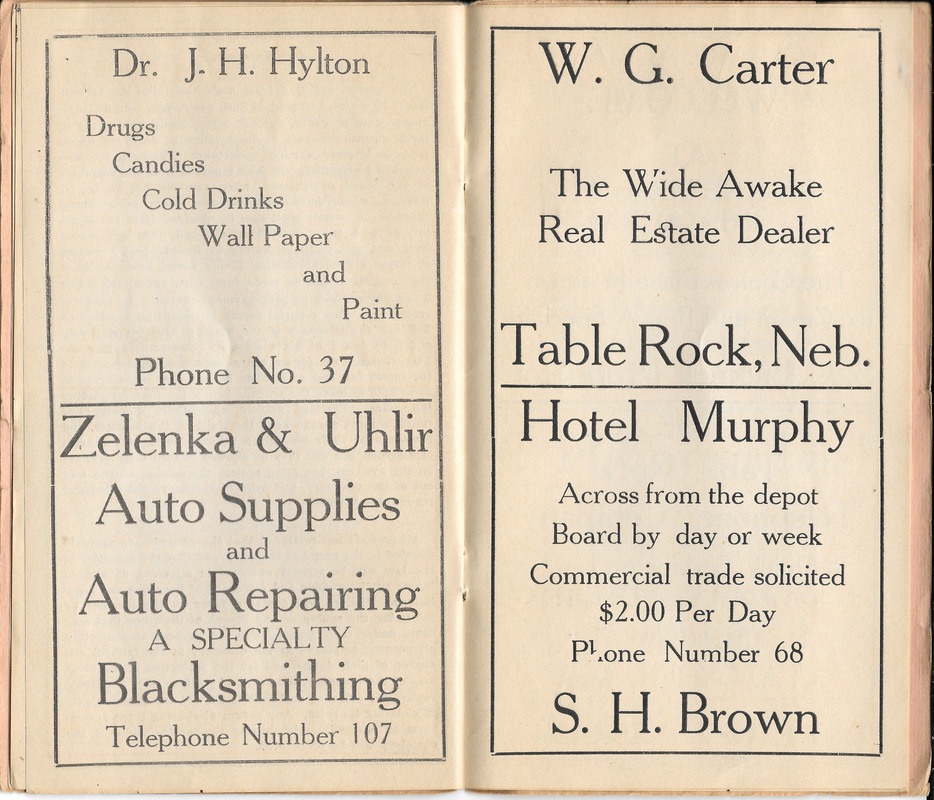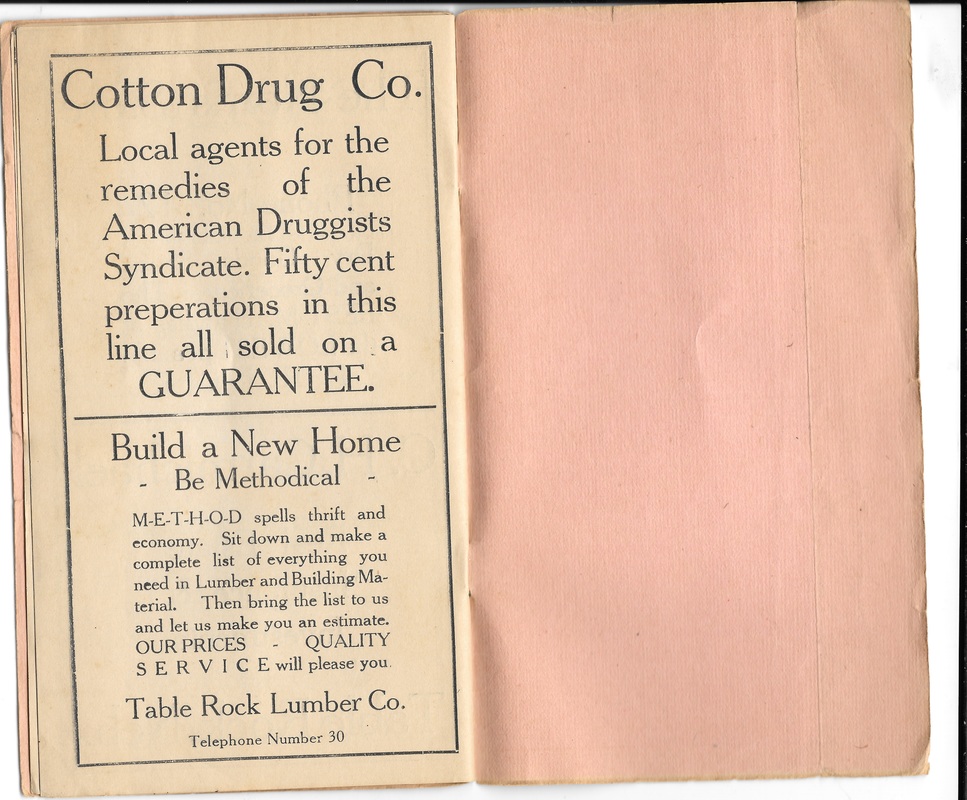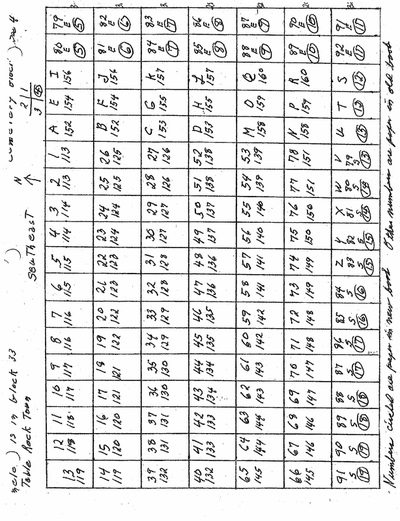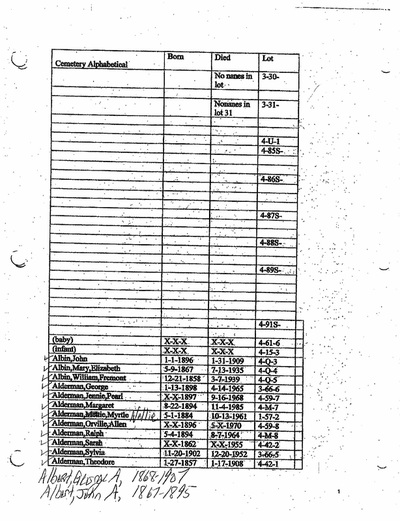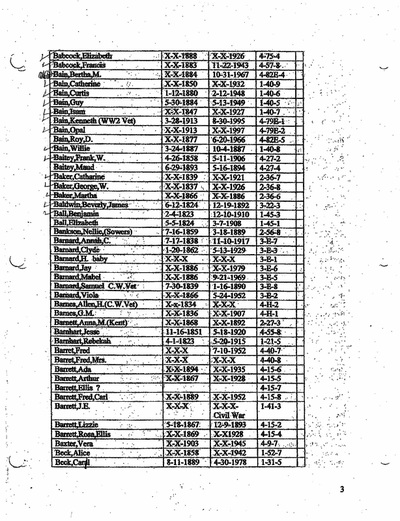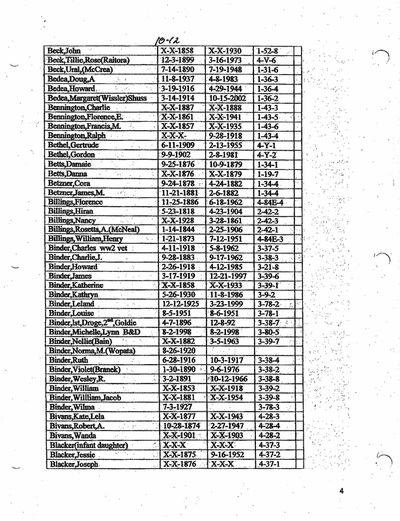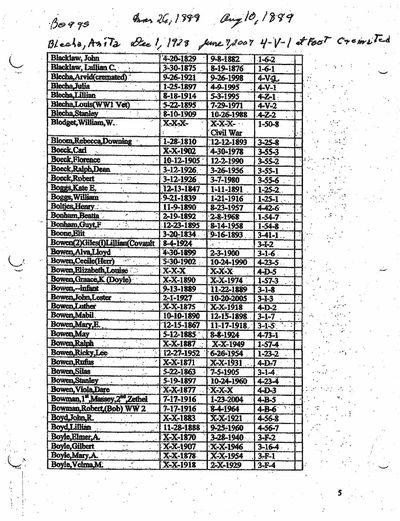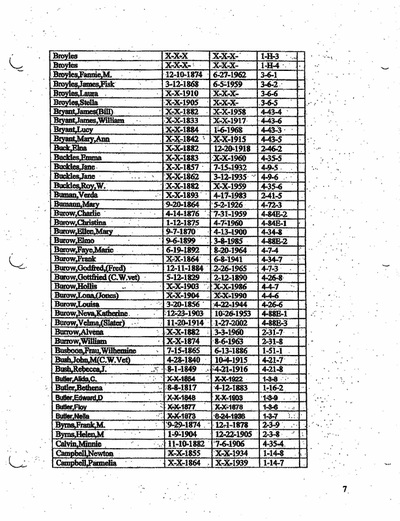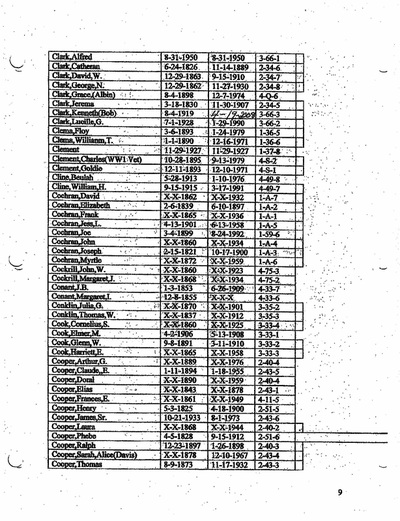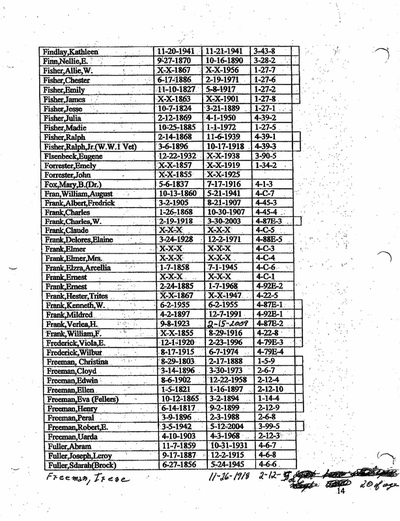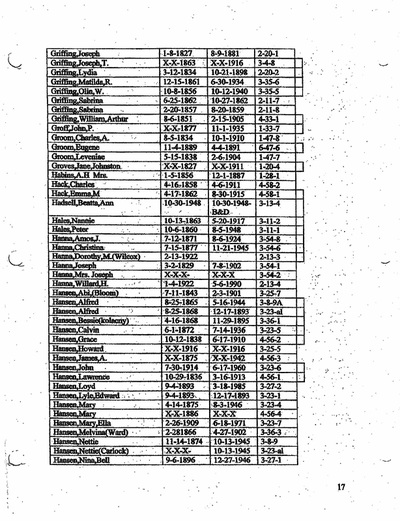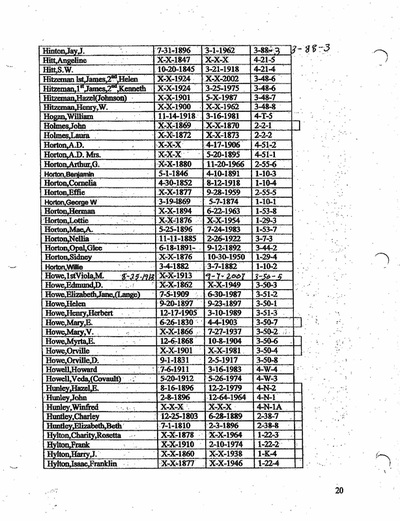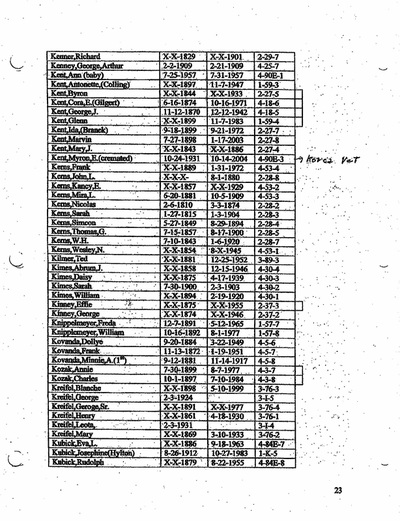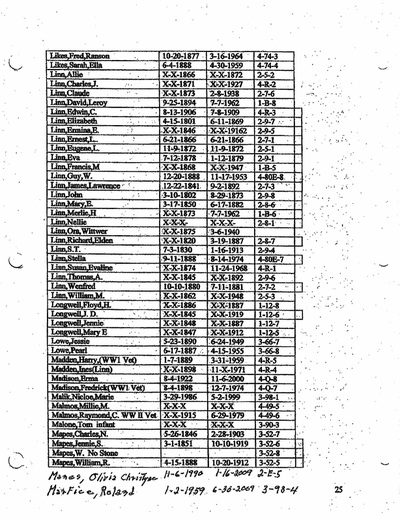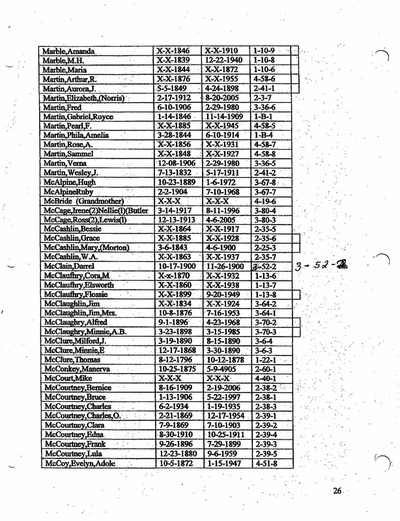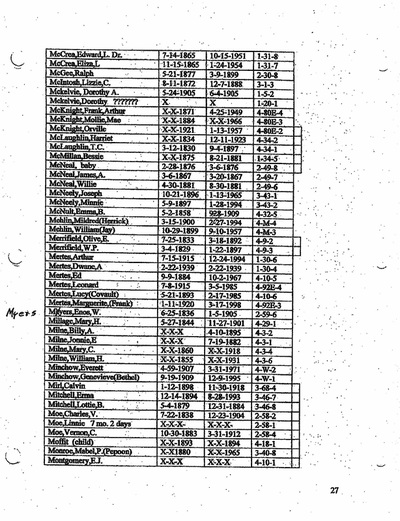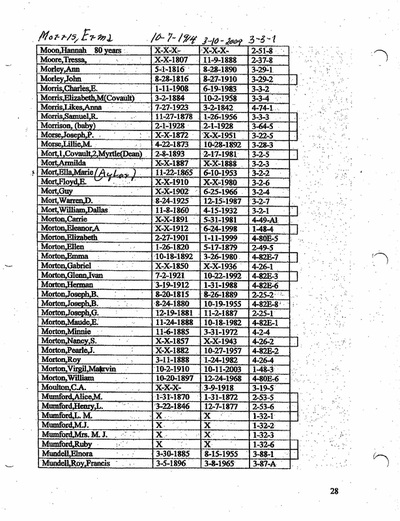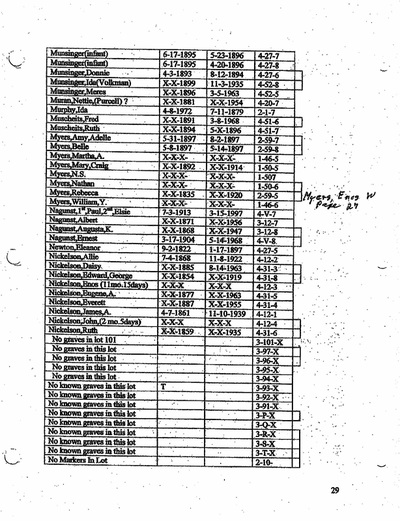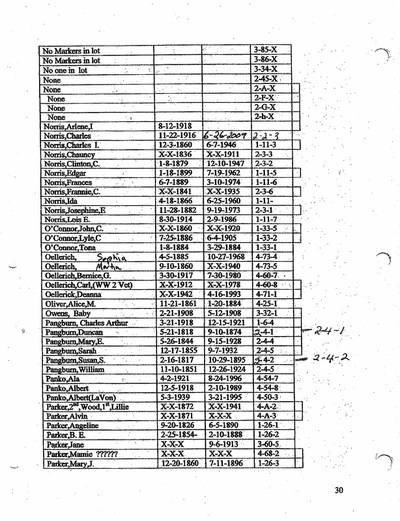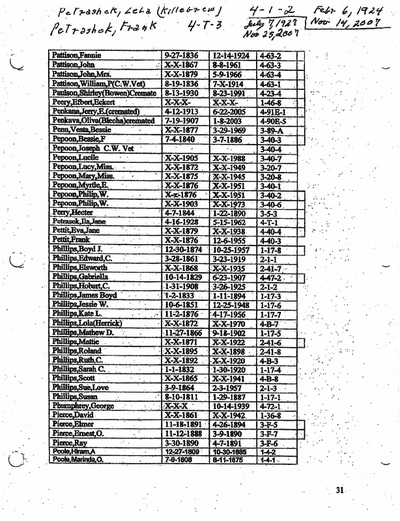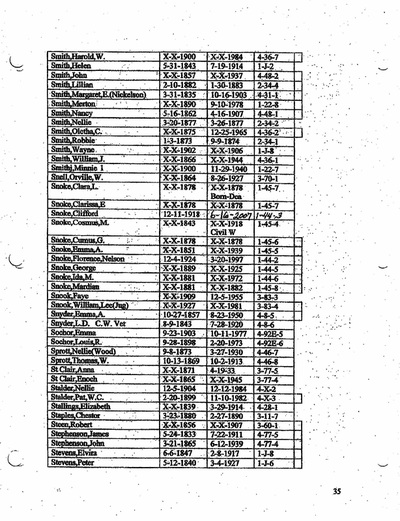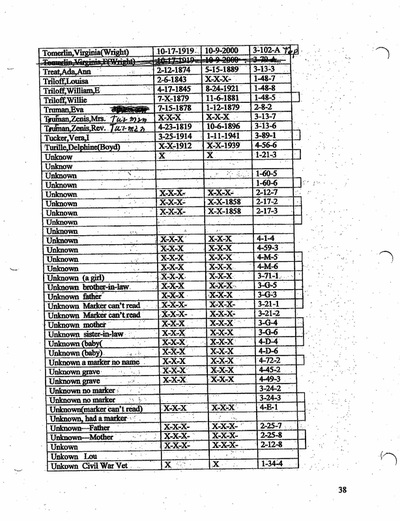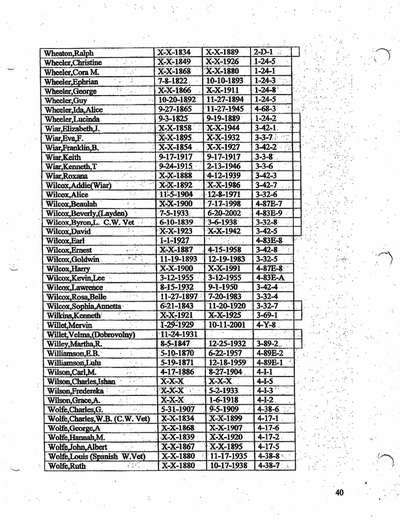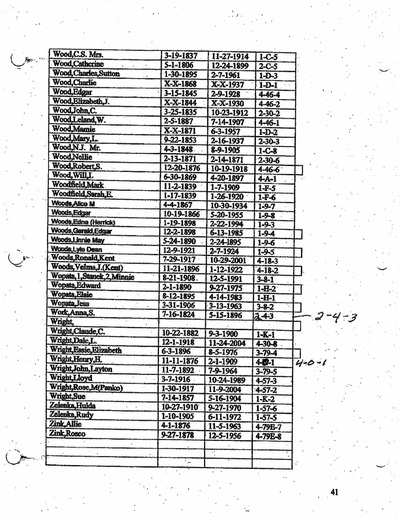the table rock cemetery
burial records for the table rock cemetery
(unofficial)
|
Download this 46-page pdf file. These records have not been updated for quite some time, but you will find a large number of entries here nonetheless.
A second source is FindaGrave.com. There is a smartphone app for this website. You can search by name, and you will find that photographs & obituaries, when available, have been added to the individual memorials by the Table Rock Historical Society. Thank you to member Luella Hinrichsen for this Herculean effort of finding and adding obituaries! |
| ||||||
slide shows of some of the tombstones
A to C |
d to h |
i to K |
|
|
|
|
about the cemetery
how old is it?
|
The Table Rock Cemetery is located on the west edge of the Village of Table Rock and is bounded by Pennsylvania and Luzerne Streets and 9th and 10th Streets.
In 1903, an imposing 23-foot high Civil War monument of sandstone in the northeast corner of the cemetery was dedicated. by the Grand Army of the Republic and its auxiliary, the Woman’s Relief Corps. It is a monument to the unknown soldier, and features a Union soldier looking East as he stands at parade rest. There are 60 Civil War veterans known to be buried in the cemetery, including several in unmarked graves; most settled in Table Rock after the Civil War. The Table Rock Cemetery Association was established in 1880, but the cemetery itself had existed for over 20 years by that time. The first two persons to be buried there are unknown. The third was Hannah Jane Gere, who died at age 31 on July 18, 1857. The Gere family had come in 1856, one of the first families to arrive of those who came here under the auspices of the Nebraka Settlement Company. Horatio N. and Juliana Gere brought four of their five children, Julia Marie, age 16, John, age 14, Hannah Jane, age 12 and George, age 9. The oldest, Chester (C. H.) remained in the East at college and, after graduation, as a Union soldier in the Civil War. He later joined the family but, as an adult with ambition, quickly move on. In her short diary, Juliana Gere marked the onset of Hannah Jane's illness, describing the dramatic and horrifying course of symptoms of what was probably typhus and how Hannah Jane and her family dealt with the illness. |
|
Juliana wrote that following a funeral the day after Hannah Jane died, "Nearly every person present followed her dear form to its final resting place which is about ½ mile distant and is as lovely a spot as I could have selected. Hers was the third grave in the new burial ground on the Town site." The "new burial ground" was almost certainly the Table Rock Cemetery. Hannah Jane's grave is unmarked and the location not recorded by modern burial records, which are based on a later walk through and annotation of the graves then marked. However, perhaps it is one of the three simple headstones lined up on the north side of the large flat mysterious tombstone bearing the date of 1858. None of those smaller stones are dated, and from the tool marks on them one can see that there never were inscriptions on them.
1858 was a year of floods, which wiped out many homes, most of which had been built in low lying areas near the river and creeks. After the flood waters receded, they left great illness as an aftermath. Some accounts of the time relate that at times so many people were ill that there were not enough who were healthy enough to care for them. Lydia Griffing related that when she succumbed to illness while caring for her husband, they both lay in bed, unable to rise even to care for their baby, and expected death; a young man who lived nearby came to see them and stayed to nurse them to health.
As a side note, it was Hannah's brother John who was killed by Indians in 1870 while at a homestead in Kansas, and whose tombstone in the Table Rock Cemetery says that, "Beloved Husband" and "Killed by Indians." He had married Lydia Giddings, one of the daughters of the founder of Table Rock, Charles W. Giddings. There are many spaces to either side of John Gere's grave and one wonders whether they are occupied in part by the unmarked graves of H. N. Gere and Juliana Gere, the parents and John's sisters Hannah Jane and Julia (who died not long after Hannah Jane).
Below, you will find a 1975 history of the cemetery by then sexton J. C. Layden, which is packed with information. You will also find photographs of the cemetery and links to various subjects relating to the cemetery.
1858 was a year of floods, which wiped out many homes, most of which had been built in low lying areas near the river and creeks. After the flood waters receded, they left great illness as an aftermath. Some accounts of the time relate that at times so many people were ill that there were not enough who were healthy enough to care for them. Lydia Griffing related that when she succumbed to illness while caring for her husband, they both lay in bed, unable to rise even to care for their baby, and expected death; a young man who lived nearby came to see them and stayed to nurse them to health.
As a side note, it was Hannah's brother John who was killed by Indians in 1870 while at a homestead in Kansas, and whose tombstone in the Table Rock Cemetery says that, "Beloved Husband" and "Killed by Indians." He had married Lydia Giddings, one of the daughters of the founder of Table Rock, Charles W. Giddings. There are many spaces to either side of John Gere's grave and one wonders whether they are occupied in part by the unmarked graves of H. N. Gere and Juliana Gere, the parents and John's sisters Hannah Jane and Julia (who died not long after Hannah Jane).
Below, you will find a 1975 history of the cemetery by then sexton J. C. Layden, which is packed with information. You will also find photographs of the cemetery and links to various subjects relating to the cemetery.
more information
the civil war statue and more
CIVIL WAR STATUE
This monument is made of Indiana lime stone, stands 21 feet tall, and weighs 31,600 pounds. It originally cost $600. The soldier is 7 feet tall and is of the type known as “the Silent Sentinel.” It weighs over 1000 pounds.
When this Civil War monument was dedicated on a cold winter day in December 1903, it was referred to as the monument to the unknown dead of the Civil War. Because of the cold, the dedication ceremony was held in the Opera House, which had 200 chairs. There was standing room only. Speakers included members of the Grand Army of the Republic – the Union veterans – and a popular Confederate who lived here as a true patriot. After the dedication ceremony of this monument, a procession to the cemetery was led by the GAR, whose members “despite the weight of years” on many of them, marched the entire way that wintry day.
There are two confederates buried here, R. P. Jennings and Tom Shorter, Here’s a story about them from the Table Rock Argus newspaper.
The old soldiers of the G.A.R. were marching to the cemetery for what was then called Decoration Day. Along the way, Jennings and Shorter stood on the sidewalk together. The column was stopped, and the Lieutenant leading them called out: “Jennings. Shorter. Fall in! And every year after Jennings and Shorter marched with their former enemies. Jennings was given the honor of bearing the flag. When each died, the G.A.R. rendered the honor of attending the funeral as a group. And so the veterans reconciled, fulfilling a friendship in the spirit of the huge reunion of veterans at Gettysburg for the 50th Anniversary of that battle, attended by several Table Rock men, including R. P. Jennings, the confederate.
There are about 60 veterans buried in this cemetery besides the two Confederates. Many participated in famous battles, including Chancellorsville, Gettysburg, Antietam, Vicksburg, Appomattox, and also in Sherman’s March to the Sea. Some bore the marks of injury, such as John Shaw, who was shot in the face at the Battle of Shiloh. There are soldiers buried here who were in the infamous prisons of Andersonville in George, and Libby Prison in Virginia.
There are parents here who lost children to the war, Nicholas and Sarah Kerns. And there are also war widows buried here, Margaret Layman, Dr. Mary B. Fox, whose husband died in Andersonville Prison and Nancy Taylor, whose husband was killed, remarried, and then her second husband was killed.
In addition to the Civil War veterans stories of those who lie within this cemetery abound. There are conductors of the Underground Railroad, which ran through Table Rock, which is recognized as a site under a the National Park Service’s Underground Railroad Network to Freedom. There are homesteaders who turned the first furrow, housewives who prided themselves on having the whitest sheets hung out on their clotheslines, merchants from the time when the streets were dirt, undertakers, victims of unsolved murders, two men who moved houses, churches, and other buildings for a living, soldiers who fell in other wars, fire chiefs, and more.
Our most interesting stones are in the northwest quarter, where lie the oldest. There you will find “the Mysterious tombstones,” hand made. Only one bears text, and that is the year 1858, a cross, and script letters which have been given various interpretations. Four others are nearby, including one that used to have a tent shape and which can be found in cemeteries in the south. No one knows who is buried here, although there are some educated guesses. Nearby is the stone of John N. Gere, who came here as a young boy in 1857, served in the Civil War, and who died in 1870. As his tombstone says, he was “Killed by Indians.” It occurred in Kansas though, at the end of the period of Indian troubles.
If you are interested in a tour of the cemetery, contact the Table Rock Historical Society.
This monument is made of Indiana lime stone, stands 21 feet tall, and weighs 31,600 pounds. It originally cost $600. The soldier is 7 feet tall and is of the type known as “the Silent Sentinel.” It weighs over 1000 pounds.
When this Civil War monument was dedicated on a cold winter day in December 1903, it was referred to as the monument to the unknown dead of the Civil War. Because of the cold, the dedication ceremony was held in the Opera House, which had 200 chairs. There was standing room only. Speakers included members of the Grand Army of the Republic – the Union veterans – and a popular Confederate who lived here as a true patriot. After the dedication ceremony of this monument, a procession to the cemetery was led by the GAR, whose members “despite the weight of years” on many of them, marched the entire way that wintry day.
There are two confederates buried here, R. P. Jennings and Tom Shorter, Here’s a story about them from the Table Rock Argus newspaper.
The old soldiers of the G.A.R. were marching to the cemetery for what was then called Decoration Day. Along the way, Jennings and Shorter stood on the sidewalk together. The column was stopped, and the Lieutenant leading them called out: “Jennings. Shorter. Fall in! And every year after Jennings and Shorter marched with their former enemies. Jennings was given the honor of bearing the flag. When each died, the G.A.R. rendered the honor of attending the funeral as a group. And so the veterans reconciled, fulfilling a friendship in the spirit of the huge reunion of veterans at Gettysburg for the 50th Anniversary of that battle, attended by several Table Rock men, including R. P. Jennings, the confederate.
There are about 60 veterans buried in this cemetery besides the two Confederates. Many participated in famous battles, including Chancellorsville, Gettysburg, Antietam, Vicksburg, Appomattox, and also in Sherman’s March to the Sea. Some bore the marks of injury, such as John Shaw, who was shot in the face at the Battle of Shiloh. There are soldiers buried here who were in the infamous prisons of Andersonville in George, and Libby Prison in Virginia.
There are parents here who lost children to the war, Nicholas and Sarah Kerns. And there are also war widows buried here, Margaret Layman, Dr. Mary B. Fox, whose husband died in Andersonville Prison and Nancy Taylor, whose husband was killed, remarried, and then her second husband was killed.
In addition to the Civil War veterans stories of those who lie within this cemetery abound. There are conductors of the Underground Railroad, which ran through Table Rock, which is recognized as a site under a the National Park Service’s Underground Railroad Network to Freedom. There are homesteaders who turned the first furrow, housewives who prided themselves on having the whitest sheets hung out on their clotheslines, merchants from the time when the streets were dirt, undertakers, victims of unsolved murders, two men who moved houses, churches, and other buildings for a living, soldiers who fell in other wars, fire chiefs, and more.
Our most interesting stones are in the northwest quarter, where lie the oldest. There you will find “the Mysterious tombstones,” hand made. Only one bears text, and that is the year 1858, a cross, and script letters which have been given various interpretations. Four others are nearby, including one that used to have a tent shape and which can be found in cemeteries in the south. No one knows who is buried here, although there are some educated guesses. Nearby is the stone of John N. Gere, who came here as a young boy in 1857, served in the Civil War, and who died in 1870. As his tombstone says, he was “Killed by Indians.” It occurred in Kansas though, at the end of the period of Indian troubles.
If you are interested in a tour of the cemetery, contact the Table Rock Historical Society.
the five mysterious tombstones |
1975 history of
the table rock cemetery association
By then sexton J. C. Layden
CEMEtery by laws, 1915
Thank you to Willard Binder, President of the Table Rock Cemetery Board, for lending me a carefully-preserved copy of the by-laws. He proffered it one summer afternoon in 2015, a century after it had originally been distributed.
winter 2010
|
Photos of the cemetery in 2010, by Sharla (Sitzman) Cerra and Suzanne (Sitzman) Ellis.
|
See more photos |
burial records for
the table rock cemetery
These are the records usually consulted for burials There are scraps and pieces of old records which sometimes yield more information. If you need help, talk with someone from the Table Rock Cemetery Association. Email [email protected] for help with that.
To read, scan down. There are 45 total pages. After this pdf file is a "gallery" with the same documents as photos, page by page.
To read, scan down. There are 45 total pages. After this pdf file is a "gallery" with the same documents as photos, page by page.
Your browser does not support viewing this document. Click here to download the document.

